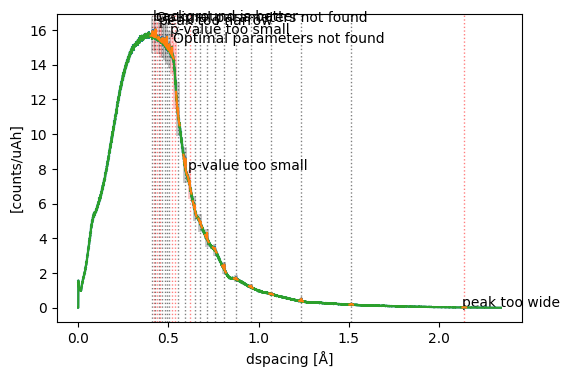Vanadium processing#
The main workflow in POWGEN_data_reduction misses some reduction steps for vanadium. In particular, we need to remove coherent scattering peaks from vanadium data. This is not part of the regular workflow as it relies on fitting. And since fitting can easily break in a way that is hard to detect automatically, a human should inspect the results. Additionally, vanadium measurements can be processed separately from sample measurements and saved to files. The processed vanadium data can then be used in the main workflow directly.
This notebook outlines how to process a vanadium run. First, we convert the data to d-spacing using the same workflow as in POWGEN_data_reduction.
[1]:
import plopp as pp
import scipp as sc
import scippneutron as scn
import scippneutron.peaks
from ess import powder
from ess.snspowder import powgen
from ess.powder.types import *
Use the same parameters as in the main workflow except with more d-spacing bins. We need the high d-spacing resolution later when removing coherent scattering peaks.
[2]:
workflow = powgen.PowgenWorkflow()
# Use a large number of bins.
workflow[DspacingBins] = sc.linspace("dspacing", 0.0, 2.3434, 5001, unit="angstrom")
workflow[Filename[SampleRun]] = powgen.data.powgen_tutorial_sample_file()
workflow[Filename[VanadiumRun]] = powgen.data.powgen_tutorial_vanadium_file()
workflow[CalibrationFilename] = powgen.data.powgen_tutorial_calibration_file()
workflow[UncertaintyBroadcastMode] = UncertaintyBroadcastMode.drop
workflow[TofMask] = lambda x: (x < sc.scalar(0.0, unit="us")) | (x > sc.scalar(16666.67, unit="us"))
workflow[TwoThetaMask] = None
workflow[WavelengthMask] = None
workflow = powder.with_pixel_mask_filenames(workflow, [])
Compute a single vanadium spectrum in d-spacing:
[3]:
peaked_data = workflow.compute(FocussedDataDspacing[VanadiumRun])
[4]:
peaked_data
[4]:
- dspacing: 5000
- dspacing(dspacing [bin-edge])float64Å0.0, 0.000, ..., 2.343, 2.343
Values:
array([0.00000000e+00, 4.68680000e-04, 9.37360000e-04, ..., 2.34246264e+00, 2.34293132e+00, 2.34340000e+00], shape=(5001,)) - gd_prtn_chrg()float64µAh3777.917473130555
Values:
array(3777.91747313) - sample_position()vector3m[0. 0. 0.]
Values:
array([0., 0., 0.]) - source_position()vector3m[ 0. 0. -60.]
Values:
array([ 0., 0., -60.])
- (dspacing)DataArrayViewbinned data [len=0, len=2765, ..., len=0, len=0]
dim='event', content=DataArray( dims=(event: 65836865), data=float64[counts/uAh], coords={'pulse_time':datetime64[ns], 'dspacing':float64[Å]}, masks={'tof':bool})
[5]:
peaked_data.hist().plot()
[5]:
Removing coherent scattering peaks#
As the variable name peaked_data implies, the produced spectrum contains peaks from coherent scattering. Even though the peaks are small for vanadium, we need to remove them to extract pure incoherent scattering. We can approximate the coherent scattering contribution by fitting functions to the peaks and subtracting those fitted functions. scippneutron.peaks contains general functionality for fitting and
removing peaks. Here, we use it through ess.snspowder.powgen.peaks which provides useful defaults for vanadium peaks at POWGEN. For example, it selects appropriate models for peaks (gaussian) and backgrounds (linear and quadratic).
First, define estimates for the peaks based on the known crystal structure of vanadium:
[6]:
peak_estimates = powgen.peaks.theoretical_vanadium_dspacing(
hkl_range=7, min_d=sc.scalar(0.41, unit='angstrom')
)
We need to histogram the data to perform fits:
[7]:
peak_histogram = peaked_data.hist()
The fits require a bin-center coordinate, so convert from bin-edges:
[8]:
to_fit = peak_histogram.copy(deep=False)
to_fit.coords['dspacing'] = sc.midpoints(to_fit.coords['dspacing'])
Perform the fits:
[9]:
fit_results = powgen.peaks.fit_vanadium_peaks(to_fit, peak_estimates=peak_estimates)
Remove the fitted peaks to obtain the incoherent scattering. Also restore the bin-edge coordinate that we had to replace temporarily for the fits.
Importantly, we remove variances from the data. If we kept the variances, subtracting the fitted models would introduce correlations between the data points. This corresponds to UncertaintyBroadcastMode.drop in the main workflow. See also the guide in ESSreduce.
[10]:
incoherent = scn.peaks.remove_peaks(sc.values(to_fit), fit_results)
incoherent.coords['dspacing'] = peak_histogram.coords['dspacing']
incoherent.plot()
[10]:
We can further inspect the results. Below, there is a function that plots
the data with coherent and incoherent scattering (blue),
the resulting incoherent curve (green),
the fitted models (orange),
the fit windows (gray and red boxes),
and the initial estimates (dashed vertical lines).
Some fits failed as indicated by red boxes and short descriptions of why the fits failed. Some peaks are absent from the data used here, even though they are expected based on the crystal structure. So those fits are expected to fail. All other fits appear to have succeeded.
See scippneutron.peaks.fit_peaks for options to customize the fit procedure if it does not work as desired.
Note
It is highly recommended to inspect the plot in detail to check whether all fits have succeeded or failed as expected! Fitting is not always reliable and may fail for many reasons. You can make plots interactive by using %matplotlib widget.
[11]:
def peak_removal_diagnostic(
data: sc.DataArray,
removed: sc.DataArray,
fit_results: list[scn.peaks.FitResult],
peak_estimates: sc.Variable,
*,
xlim: tuple[sc.Variable, sc.Variable] | None=None,
):
if xlim is not None:
def in_range(x: sc.Variable) -> bool:
return sc.isfinite(x) and (xlim[0] <= x) and (x < xlim[1])
data = data[data.dim, xlim[0]:xlim[1]]
removed = removed[removed.dim, xlim[0]:xlim[1]]
fit_results, peak_estimates = zip(*(
(r, e)
for r, e in zip(fit_results, peak_estimates, strict=True)
if in_range(r.window[0]) and in_range(r.window[1])
), strict=True)
# The actual data
plot_data = {'data': data, 'removed': removed}
linestyles = {}
markers = {}
colors = {'data': 'C0','removed': 'C2'}
# Overlay with fit models evaluated at optimized parameters
for i, result in enumerate(fit_results):
if all(not sc.isnan(param).value for param in result.popt.values()):
best_fit = data[data.dim, result.window[0] : result.window[1]].copy(deep=False)
best_fit.coords[best_fit.dim] = sc.midpoints(best_fit.coords[best_fit.dim])
best_fit.data = result.eval_model(best_fit.coords[best_fit.dim])
key = f'result_{i}'
plot_data[key] = best_fit
linestyles[key] = '-'
markers[key] = "none"
colors[key] = "C1"
fig = pp.plot(plot_data, ls=linestyles, marker=markers, c=colors, legend=False)
ax = fig.ax
# Initial estimates
for estimate, result in zip(peak_estimates, fit_results, strict=True):
ax.axvline(
x=estimate.value,
color="black" if result.success else "red",
alpha=0.5,
lw=1,
ls=":",
)
# Fit windows
for result in fit_results:
left = result.window[0]
right = result.window[1]
sl = data[data.dim, left:right]
lo = sl.min().value * 0.95
hi = sl.max().value * 1.05
ax.fill_betweenx(
(lo, hi),
left.value,
right.value,
facecolor="black" if result.success else "red",
alpha=0.2,
)
if not result.success:
ax.text(left.value, hi, result.message.split(":", 1)[0])
return fig
[12]:
peak_removal_diagnostic(
peak_histogram,
incoherent,
fit_results,
peak_estimates,
)
[12]:

[13]:
peak_removal_diagnostic(
peak_histogram,
incoherent,
fit_results,
peak_estimates,
xlim=(0.37 * sc.Unit("Å"), 0.56 * sc.Unit("Å")),
)
[13]:
The resulting data array incoherent can be saved and used in the main workflow POWGEN_data_reduction to replace FocussedDataDspacing[VanadiumRun].